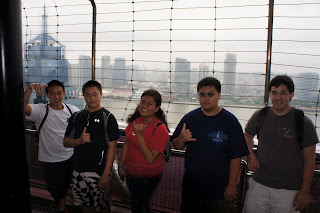Monday, July 16, 2012
Thursday, July 5, 2012
Guilin, Li River
Locals call this 9 horse mountain because they think they can see 9 horses on the sheer cliff. Nine is an important number in Chinese. I think I can see one at the top but not 9.
Guilin, Li River
Many of the local fisherman use cormorants for fishing. It takes a year to train these birds to fish for their master. They only fish at night. A lantern is put in the water at night to attract fish and the cormorants dive under the surface to catch the fish and return it to the fisherman's boat. Night is required to both attract the fish and prevent the cormorants from being seen by the diving birds. This has been practiced for centuries.
Guilin, Li River
Locals paddle their bamboo rafts along side our boats, hook a rope to the boat trying to sell fruit while being dragged by the boat... mostly grapes and lychee. I never saw any takers. The boat captains don't seem to mind.
Guilin, Li River Valley
Towards the end of the Li River Cruise, the land flattens somewhat at riverside but the same majestic mountains permeates the landscape along with scattered rice fields. Only God/Nature can make sights such as these.
Wednesday, July 4, 2012
Monday, July 2, 2012
Guilin
We flew out of Shanghai on to Guilin (pron "Guay Lin"..pop 4.7 million). This was one of my most anticipated pleasures of our China tour. Established in 314 BC along the Li River (pron "Lee"). Most come here to do what we did, cruise the Li River and see the beauty of this region. The motel was modern and fantastic.
Suzhou
Most of the bridges over the canals have been rebuilt over the years but many display bases that are centuries old like this one.
Suzhou
We boarded this boat to travel around the city within its canals.. which are extensive. Many of its inhabitants live and work on these canals which are part of the lower delta region of the Yangtze River.
Suzhou China
From Shanghai we traveled by bus 90 minutes northwest to the ancient city of Suzhou population about 4 million. It was established in 514 BC and this pic shows all that is left of a wall built around the original city. Suzhou has over 2,500 years of rich history, and relics of the past are abundant to this day. The city's canals, stone bridges, pagodas and gardens make it a popular attraction to tourists. The silk industry has been strong here for a thousand years.
Bund Memorial & History
This concrete memorial on the Bund represents three rifles and celebrates the fallen from the revolution that eventually established the People's Republic of China in 1949. Mao Zedong of course is given credit for this which is why his image is all over their buildings and money. Ironically, he is also the author of the 10 year long Cultural Revolution, considered a dark time in China's history even by the Chinese. This is when they stripped all the wealthy people of their possessions since they "accumulated it from capitolism" and during this time as well as during the revolution, millions of their own citizens were murdered. The cultural revolution is hardly mentioned in their schools today. Mao has the distinguished honor of being the greatest mass murderer in human history.. three times that of Hitler. Ironically, Shanghai is the epitome of capitolism and capitolism is the only thing that has brought China out of the dark ages... and the government knows it.. but the people do not! The vast majority absolutely love their government.
Shanghai's Bund
This is the famous Bund in Shanghai, a waterfront area in central Shanghai running along the Huangpu River. Building heights are restricted in this area because of the dozens of historical buildings in the area. The pic to follow shows the other side of the river all still in Shanghai.
Shanghai, Modern Market Place
Modern shopping areas in Shanghai (of which there were many). It rained the 2 1/2 days we were in Shanghai. Shanghai gets a lot of rain (100 days a year). Note the MacDonald's and KFC. Outside of these two common fast food chains here, there is not much purely western restaurants to be found though we did enjoy Papa Johns one evening.
Shanghai, Dragons
Symbolism abounds in China. In the west, the dragon has a negative connotation (evil, aggressive, & cold blooded) but in China and asia in general it is quite different. The dragon represents divinity, power, immortality, procreation, fertility, activity and good fortune. Many of the dynasties would not allow the likeness of a dragon to be worn by the common folk because the dragon was a God as the Emperor felt he was as well. Of the dynasties that did allow one to display a dragon on a building or anything certain rules must be obeyed. Only the Emperor could wear or display yellow or gold. Only the Emperor's dragon figures could show 5 fingers. Note this one shows three. Only the Emperor could have a ball in the mouth resembling a pearl (the ball in a dragon's mouth demonstrated that the dragon could fly up and swallow the sun if he wished). Today if you can remove the ball, you will be very properous but even touching it brings good luck. The longer the whiskers, the more powerful the dragon. The frog below the dragon represents the common folk and if they were to catch the saliva of the dragon, their lives would be more properous. This dragon image is in Shanghai in a famous garden built in 1577 so the Ming Dynasty (1368-1644) allowed such images. Many older Chinese hold on to these beliefs.
Subscribe to:
Comments (Atom)
















































